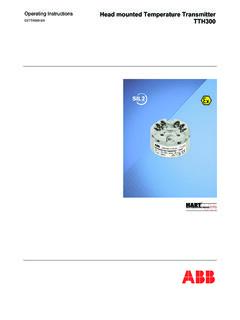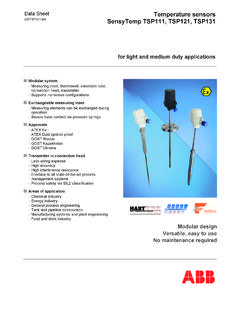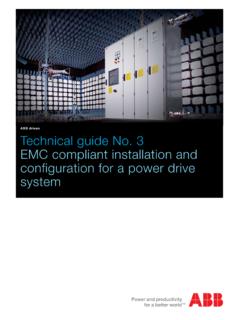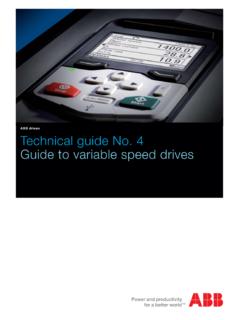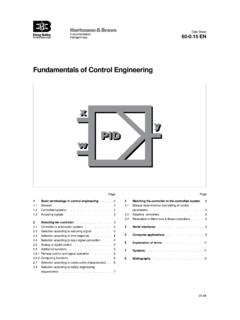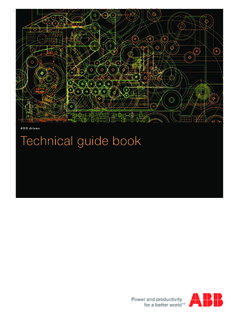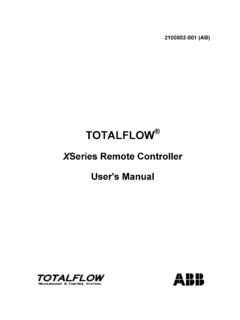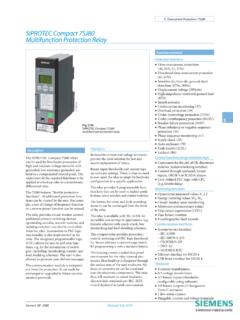Transcription of Technical Guide 15 kV, 23 kV, & 35 kV - ABB
1 Protective Link Expulsion fuse Type Prolink, Oil Immersed, PTAP-APR925. IZUA 5670-100. Technical Guide 15 kV, 23 kV, & 35 kV. ABB. General Description Table 1: Interruption Rating The Protective link is an oil immersed, expulsion type, fuse assembly for use in the high voltage circuit of a distribution Application Voltage1. Interrupting Rating2. (rms symmetrical Amperes). transformer. Used in coordination with the CSP circuit breaker, the protective link's function is to disconnect a defective 2,400 5,000. transformer from the feeder circuit, and to limit the severity of the damage to the transformer in case of an internal fault.
2 4,800 4,800. The link consists of a fuse wire element contained within a hard fiber tube. The wire is welded to a top electrode at one 7,200 3,500. end and crimped to a bottom electrode or welded directly to the cable lead at the other end. Protective links are available 12,000 3,000. in a wide variety of fuse sizes and kV classes for proper 14,400 2,500. coordination with CSP circuit breakers. 23,000 1,200. Application Information 34,500 1,200. fuse Curve Selection 1. Application Voltage listed as: When designing a CSP protection scheme, the secondary Single Phase: Line to Ground CSP circuit breaker is selected first.
3 After the secondary circuit Three Phase: Line to Line breaker is selected, the protective link is chosen so that proper 2. Interruption ratings are based on a well constructed round tank coordination between the primary side protective link and the distribution transformer. Ratings will generally be greater for pad secondary side circuit breaker is achieved. The simplest way mounted distribution transformers because of the rectangular tank's ability to absorb a considerable ammount of energy to determine if proper coordination has been achieved is to during high current fault interruption. compare the time versus current characteristics curves (TCC.)
4 Curves) of both devices. coordination is acceptable when, for all values of secondary fault current, the circuit breaker will clear the fault before the protective link melts. The protective links are produced in a wide range of fuse sizes which are described on curve drawing 697700 for minimum melt Figure 1: characteristics and curve drawing 735701 for average clearing Schematic Diagram of CSP Transformer characteristics. Circuit Connection The protective link is connected between the primary winding and high voltage bushing. In a transformer with a single high voltage bushing (where one end of the primary winding is connected to the ground), one protective link per transformer is used.
5 In a transformer with two high voltage bushings, two protective links are used. A typical CSP transformer schematic diagram is shown in Figure 1. A jack bolt (style number 240A394H01 ordered separate) fits into the x 28 thread in the top terminal of the protective link and may be used to make up the top connection to the link. In lieu of this bolt, any standard diameter x 28. threads per inch x thread length bolt will work. The lower connection to the protective link is made through the flexible cable lead. The flexible cable lead is specified on the dimension sheets as: number of wire strands - individual wire strand thickness (example = 259 strands of diameter wire).
6 Mounting Information Protective links may be mounted in any orientation as long as the expulsion arc will be under oil during arc interruption. Standard mounting configuration is in a near vertical to vertical 2 ABB. position in round tank transformers and horizontal to vertical in pad mounted units. All energized parts of the protective link must be under oil and spaced away from all other Figure 3: energized or grounded parts with sufficient distance to Block Mounting - 584B903H01. withstand all operating and test voltages. The transformer tank design must be capable of absorbing the arc energy of the protective link through tank venting or other means.
7 The interrupting rating of this device is a function of the tank design Protective Link and the live part insulation. See the appropriate breaker application manual for coordination with CSP breakers. Mounting Accessories Mounting Hole - bolt to Three different methods may be used to mount Protective insulating member Links: a narrow groove flat clip bolted to an insulator, retaining of transformer rings and terminal block, or directly mounted to an insulating superstructure mounting block. The narrow groove flat clip (75D0426H01) is placed in the small groove around the protective link, the ends are closed Retaining Clips together, the mounting bolt is run through the eye ends of the (above & below).
8 Mounting clip, and is bolted to the insulating structure. The bolt holds the clip closed around the protective link, as well as securing the link to the insulating structure. The retaining rings (style number 9820A65H05) fit into two Terminal Block small grooves on the fiber tube body and secures the fuse in the terminal block (style number 584B903H01). This mounting arrangement is shown in Figure 3. Cable Lead The protective link may also be mounted using an insulating block. This mounting scheme is shown in Figure 4. Details and dimensional information for this block may be found on Dimension Sheet 44-889 Pg 13.
9 Figure 2: Link Operation Part Identification When the fuse wire melts due to a fault current, an arc is established within the fiber tube. The interaction of the arc on the fiber tube's interior wall generates gases, which (in Flat Clip Groove combination with the expulsive action of the protective link). extinguishes the arc rapidly and clears the circuit. Features & Advantages Multiple Ratings Protective links are manufactured in three voltage classes and up to thirteen different fuse curve variations. The three voltage Cable Lead classes are 15 kV, 23 kV, and 35 kV. These ratings apply to a single phase transformer's line to ground voltage, or a three phase transformer's line to line voltage.
10 For example, a three phase transformer connected to an 11kV system would use Fiber Tube the 15kV links and if connected to a 22kV system would use the 23kV links. The various fuse curves are shown on TCC. curves 697700 and 735701. Top Electrode ABB 3. Ordering Information Curve Number Current Rating <= 15kV <=23 kV <=35 kV. 2 592B581G01 779C667G01 345B995G21. 3 592B581G02 779C667G02 345B995G29. 3A 7 592B581G11 779C667G03 345B995G22. 4 592B581G06 779C667G08 345B995G33. 5 11 592B581G03 779C667G04 345B995G23. 5A 13 592B581G12 779C667G09 345B995G24. Printed in USA by Tennessee Industrial Printing Services, Inc.
